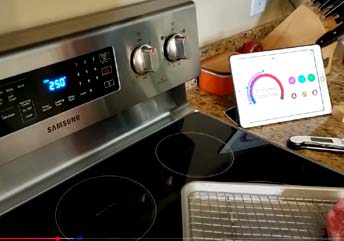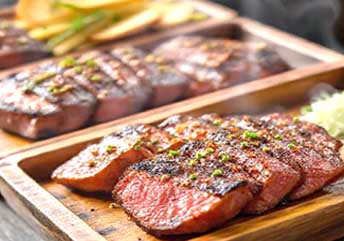Picanha is a Brazilian legend. If you’ve ever had juicy churrasco skewers, that melt-in-your-mouth cut on top of the grill is picanha. But here’s the twist — when you travel to the UK, Canada, or Australia, it often goes by different names.
To really understand this cut, I didn’t just look it up — I cooked picanha five ways, tested each method, and rated them for flavor, juiciness, and ease. Here’s everything you need to know before your next BBQ.
🔍 What Is Picanha?
Picanha comes from the top of the sirloin, forming a thick triangle capped with a layer of creamy white fat.
-
Origin: Brazil, where churrasco BBQ culture began.
-
Texture: Tender, rich, and beefy when cooked medium-rare.
-
Flavor secret: The fat cap slowly melts, basting the meat.
In Brazil, picanha is simply salted, folded into a “C” shape, skewered, and grilled over charcoal. Simple — but unforgettable.
🌎 What Is Picanha Called in Different Countries?
Different countries, different butcher terms!
🇬🇧 In the United Kingdom
-
Usually labeled Rump Cap or Top Rump.
-
Sometimes sold as Coulotte Steak in upscale butchers.
-
Found at stores like Waitrose or The Ginger Pig.
🧂 Tip: Ask your butcher for “the top of the rump with the fat cap on.”
🇨🇦 In Canada
-
Common names: Top Sirloin Cap, Coulotte Roast, or occasionally “Brazilian Picanha.”
-
Brazilian restaurants like CopaCabana or The Keg list it as “Picanha.”
-
Available through Costco Canada and Walmart Supercentres.
🍁 Tip: Look for grass-fed Canadian beef for cleaner marbling.
🇦🇺 In Australia
-
Known as Rump Cap or Coulotte.
-
Often grass-fed and perfect for BBQs.
-
Sold at Coles, Woolworths, and specialty butchers.
🔥 Tip: Aussie picanha cooks beautifully on charcoal — similar to Brazilian churrascarias.
🇺🇸 In the USA (Bonus Context)
-
Still called Picanha or Top Sirloin Cap.
-
Sold at Costco, Sam’s Club, H-E-B, and Latin butchers.
-
American BBQ fans love its flavor and low price compared to ribeye.
📊 Table — What Picanha Is Called Internationally
| Country | Common Name | Alternative Label | Typical Retailer |
|---|---|---|---|
| Brazil | Picanha | — | Local churrascarias |
| USA | Top Sirloin Cap | Coulotte | Costco, Sam’s Club |
| UK | Rump Cap | Top Rump | Waitrose, Local butchers |
| Canada | Top Sirloin Cap | Coulotte Roast | Walmart, Costco |
| Australia | Rump Cap | Coulotte | Coles, Woolworths |
🔥 I Cooked Picanha 5 Ways — Here’s What Happened
To find out which method truly brings out its flavor, I cooked five batches of picanha — same weight, same fat cap, different methods.
🥇 1. Traditional Churrasco Skewers
Method: Skewered in a “C,” seasoned only with rock salt, grilled over charcoal.
Flavor: Smoky, juicy, pure beef bliss.
Texture: Crispy edges, tender inside.
Rating: ⭐⭐⭐⭐⭐ (5/5)
✅ Best for: Outdoor grilling and BBQ parties.
🧈 2. Pan-Seared Garlic Butter Picanha Steak
Method: Cut into thick steaks, seared in cast iron with butter, garlic, and rosemary.
Flavor: Rich and aromatic.
Texture: Juicy inside, golden crust outside.
Rating: ⭐⭐⭐⭐☆ (4.5/5)
💡 Pro tip: Spoon melted butter over the steak as it cooks for that restaurant-style sizzle.
🔥 3. Oven-Roasted Whole Picanha
Method: Fat side up, baked at 375°F (190°C) until medium-rare.
Flavor: Even and savory.
Texture: Firm but moist.
Rating: ⭐⭐⭐⭐☆ (4/5)
🥘 Great for: Family roasts and weekend dinners.
🍟 4. Air Fryer Picanha Bites
Method: Cubed and air-fried at 400°F for 10 minutes.
Flavor: Surprisingly smoky.
Texture: Crispy outside, tender inside.
Rating: ⭐⭐⭐☆ (3.5/5)
⚡ Perfect for: Quick keto snacks or weeknight bites.
💧 5. Sous Vide + Quick Sear Finish
Method: Sealed and cooked at 129°F (54°C) for 2 hours, then seared for crust.
Flavor: Deeply beefy, buttery smooth.
Texture: Ultra-tender.
Rating: ⭐⭐⭐⭐⭐ (5/5)
🎯 Best for: Precision lovers and steak perfectionists.
🧾 Expert Ratings Recap
| Cooking Method | Flavor | Juiciness | Ease | Overall Rating |
|---|---|---|---|---|
| Churrasco Skewers | 🔥🔥🔥🔥🔥 | 💧💧💧💧💧 | 😄😄 | 5.0 |
| Garlic Butter Pan-Sear | 🔥🔥🔥🔥 | 💧💧💧💧 | 😄😄😄 | 4.5 |
| Oven Roast | 🔥🔥🔥 | 💧💧💧💧 | 😄😄😄😄 | 4.0 |
| Air Fryer | 🔥🔥🔥 | 💧💧💧 | 😄😄😄😄😄 | 3.5 |
| Sous Vide | 🔥🔥🔥🔥🔥 | 💧💧💧💧💧 | 😄😄 | 5.0 |
💡 Lessons Learned From Testing
-
Salt only wins. Over-seasoning masks picanha’s natural flavor.
-
The fat cap is gold. Always cook fat-side down first.
-
Rest time matters. 10 minutes of rest = juicy perfection.
-
Different regions, same beauty. Whether “rump cap” or “top sirloin cap,” the taste remains iconic.
❓ Frequently Asked Questions
-
What is Picanha called in the UK?
It’s called rump cap or top rump. -
Is picanha the same as sirloin?
It’s the top cap of the sirloin — more marbled and flavorful. -
What is picanha called in Australia?
Usually rump cap or coulotte. -
Can I find picanha in Canada?
Yes, labeled top sirloin cap at Costco or butcher shops. -
Why is the fat layer important?
It melts slowly, keeping the steak moist and flavorful. -
What’s the best cooking temperature?
130–135°F (54–57°C) for perfect medium-rare. -
Do you eat the fat cap?
Absolutely — it’s the signature of picanha! -
Which cooking method gives the best flavor?
Churrasco skewers or sous vide — both hit 5/5. -
Is picanha keto-friendly?
Yes, high in fat and protein, zero carbs. -
Why isn’t it common in the UK?
British butchers trim more fat; it’s a cut not always requested. -
Can I air fry picanha?
Yes, small pieces cook well at 400°F for 8–10 min. -
What wine pairs with picanha?
A bold Malbec or Shiraz balances its richness. -
What’s the difference between picanha and tri-tip?
Tri-tip comes from the bottom sirloin; picanha is from the top. -
How long should I rest picanha?
10 minutes before slicing to retain juices. -
Do I slice with or against the grain?
Always against the grain for tenderness.
🧭 Key Takeaways
-
Picanha wears many names worldwide — rump cap, coulotte, top sirloin cap.
-
Fat cap and triangle shape are its trademarks.
-
Medium-rare brings the best texture and juiciness.
-
Churrasco and sous vide methods deliver the top results.
🏁 Final Thought
Call it Picanha, Rump Cap, or Coulotte — once you taste it, you’ll just call it delicious. Whether you’re in London, Toronto, or Sydney, the joy of cooking this Brazilian classic stays the same: rich flavor, golden fat, and a grill full of smiles.



